Keywords
|
| PAPR, OFDM, DFT precoder, Nonlinear effect. |
INTRODUCTION
|
| Orthogonal Frequency Division Multiplexing (OFDM) is a multicarrier transmission scheme that has become the choice for next generation wireless and wireline digital communication systems because of its high spectral efficiency, high speed data rates, high quality service and robustness against narrowband interference and frequency selective fading. The use of OFDM in optical communications mitigates transmission impairments and, at the same time, provides high-data rate transmission across dispersive optical media. O-OFDM introduces spectral efficiency and tolerance to impairments such as Chromatic Dispersion (CD) and Polarization Mode Dispersion (PMD) [1]-[3] to the system. Furthermore, CO-OFDM has high spectral efficiency, which is due to not only subcarriers overlapping with each other as a special frequency division multiplexing technique but also because there is no requirement of a guard band located between the OFDM band and the optical carrier in order to avoid intermodulation distortion products arising from the nonlinear Subcarrier-To-Subcarrier Mixing Interference (SSMI) of pairs of OFDM subcarriers in the square-law photodiode. |
| Orthogonal Frequency Division Multiplexing (OFDM) is a multicarrier transmission scheme that has become the choice for next generation wireless and wireline digital communication systems because of its high spectral efficiency, high speed data rates, high quality service and robustness against narrowband interference and frequency selective fading. The use of OFDM in optical communications mitigates transmission impairments and, at the same time, provides high-data rate transmission across dispersive optical media. O-OFDM introduces spectral efficiency and tolerance to impairments such as Chromatic Dispersion (CD) and Polarization Mode Dispersion (PMD) [1]-[3] to the system. Furthermore, CO-OFDM has high spectral efficiency, which is due to not only subcarriers overlapping with each other as a special frequency division multiplexing technique but also because there is no requirement of a guard band located between the OFDM band and the optical carrier in order to avoid intermodulation distortion products arising from the nonlinear Subcarrier-To-Subcarrier Mixing Interference (SSMI) of pairs of OFDM subcarriers in the square-law photodiode. |
| The paper is organized as follows. In Section II, I explain about the related work of the proposed system. In Section III, I discuss about the scope of the research work. In Section IV, I discuss about the proposed DFT-precoded OFDM system. In section V, simulation results are discussed. Finally, in section VI, I present the conclusion of the paper. |
RELATED WORK
|
| In wireless OFDM systems, a major cause for signal degradation during transmission is high Peak to Average Power Ratio (PAPR). PAPR distribution along fiber in optical system [1] reveals the PAPR enhancement phenomenon due to the fiber nonlinearity, which causes problems in the BER performance and the required dynamic range of the receiver. Large PAPR lead to inefficient use of High Power Amplifiers (HPAs) or decreases the system performance in [2]. SPM suppression for coherent optical OFDM systems [3] utilizing three PAPR reduction methods including the clipping, the selective mapping and the partial transmit sequence. The rapid growth in multimedia-based applications [4] has triggered an insatiable thirst for high data rates and hence increased demand on OFDM-based wireless systems that can support high data rates and high mobility. As the data rates and mobility supported by the OFDM system increase, the number of subcarriers also increases, which in turn leads to high PAPR. Selected Mapping (SLM) is one efficient technique which reduces the peaks of a signal considerably. One drawback associated with this technique is its computational complexity. The computational complexity is directly related to the complexity of the IFFT block and increases as the number of sub-carriers increases. In this paper, an effort is done to reduce the computational complexity as well as to improve the PAPR performance of the conventional SLM technique. The proposed technique called Partial Selected Mapping in which the IFFT block is divided into smaller blocks and each block is used as a separate SLM block. Partial outputs of all sub-blocks are concatenated to form the final sequence. Simulation results show that the overall computational complexity of the proposed technique is lower than that of the conventional SLM technique with better PAPR performance. A reduction of around 3dB in PAPR performance at CCDF of 10-3 is achieved. Several communication systems and techniques have been used for transferring data and information reliably at high speed over wireless channel. One such technique is Orthogonal Frequency Division Multiplexing (OFDM) used for high data rate wireless transmission. In OFDM, data bits are transmitted in parallel using various carriers. Although OFDM is a multicarrier technology, it is very efficacious in mitigating the effects of multipath delay spread over a wireless radio channel. However, a major drawback with OFDM is the high Peak-to- Average Power Ratio (PAPR) of the transmitted signal. The high PAPR mainly results from certain data sequences, such as those containing all zeros or all ones. Such OFDM signals with high peaks result in poor power efficiencies. Appropriate measures should be taken to tackle this problem. Otherwise, the high PAPR signals would substantially limit the usefulness of battery powered equipment such as portable wireless devices. In addition, high peaks cause problems such as inter-symbol interference (ISI) and out-of-band radiation. Hence, it is imperative to reduce these peaks in the transmission signals. |
SCOPE OF RESEARCH WORK
|
| Orthogonal frequency division multiplexing (OFDM) has attracted much interest recently due to its increased spectral efficiency and better tolerance to transmission impairments such as chromatic dispersion (CD). Conventional OFDM technology has a subcarrier spacing equal to the symbol rate per subcarrier and uses two-quadrature formats to achieve the Nyquist rate, one of the conditions required to approach the Shannon limit to maximize the information throughput. However, if a restriction is placed on the phase differences between the sub-carriers, the minimum frequency spacing for cross talk-free operation can be reduced to half of the symbol rate per sub-carrier. Consequently, a novel scheme, optical fast OFDM (FOFDM), has been proposed for use in optical communications. This scheme also achieves the Nyquist rate, but in contrast to the conventional OFDM, uses half the sub-carrier spacing and only single quadrature modulation formats. The sub-carrier multiplexing/demultiplexing in optical FOFDM can be implemented by Discrete Cosine Transform (DCT). With this implementation, M-ary Amplitude Shifted Keying (M-ASK) Double-Side Band (DSB) FOFDM exhibits greatly reduced implementation complexity while achieving the same performance and Information Spectral Density (ISD) as conventional M-ASK Single-Side Band (SSB) OFDM. However, applying DCT-based implementation to SSB FOFDM would require a complicated Hilbert transform. In this paper, I will propose a novel Discrete-Fourier Transform (DFT) based implementation for PAPR reduction and Fiber nonlinearity mitigation when compared with the conventional OFDM system. |
PROPOSED DFT-PRECODED OFDM SYSTEM
|
| The OFDM system splits the high speed data stream into a number of parallel low data rate streams and these low data rate streams are transmitted simultaneously over a number of orthogonal subcarriers [7]. |
| Fig. 1 shows the block diagram of DFT-precoded OFDM system. The DFT a sequence of length N can be defined as |
 |
| An OFDM signal consists of sum of subcarriers that are modulated by using Quadrature Amplitude Modulation (QAM) [8]. N number of such symbols are then fed to IDFT through serial to parallel converter where N is number of subcarriers. If X0, X1,........., XN-1 are N complex QAM symbols, then output of the IDFT can be written as |
 |
| They are then converted to serial stream by parallel to serial (P/S) converter. The block of N output symbols from parallel to serial converter make one OFDM symbol. If Ts is the time duration of one input symbol to IDFT, then the total duration of a single OFDM symbol is T = NTs. The sinusoids of the DFT (or IDFT) form an orthogonal basis set and a signal in vector space of the DFT (or IDFT) can be represented as linear combination of the orthogonal sinusoids. Thus the IDFT at the transmitter maps an input signal onto a set of orthogonal subcarriers. Similarly the transform DFT is used at the receiver to reverse the mapping of IDFT and signal from the subcarriers are combined to form an estimate of the source signal from the transmitter. Since the basis function of DFT are uncorrelated, the correlation performed in DFT for the given subcarrier only sees energy for that corresponding subcarrier. The energy from other subcarrier does not contribute because they are uncorrelated. This separation of signal energy is the reason that OFDM subcarriers spectrum can overlap without causing interference. |
| The OFDM systems are implemented using a combination of Fast Fourier Transform (FFT) and Inverse Fast Fourier Transform (IFFT) that are mathematically equivalent versions of the DFT and IDFT, but are computationally more efficient. Complexity of DFT is N2 whereas that of FFT is N/2 logN. |
SIMULATION RESULTS
|
A. PAPR Analysis
|
| The PAPR of OFDM signal can be calculated by, |
 |
| where x(t) is the OFDM signal and E[-] denotes the expected value. |
| To show the PAPR analysis of DFT-precoded OFDM system, data is generated randomly then modulated by M-QAM (where M = 16, 32, 64, 256). To show the overall performance of the DFT-precoder based OFDM system for PAPR reduction in MATLAB M-QAM for N = 64 is considered. It is to be noted that M-QAM has itself PAPR. Table 1 summarises the PAPR of M-QAM (M = 16, 32, 64, 256). |
| In Fig. 2, the average of PAPR for OFDM signals is plotted to investigate the PAPR characteristics in the fiber optic channel. As the transmission distance increases, the average of the PAPR increases due to dispersion. Furthermore, when compared with the proposed system, the rate of increase in the PAPR for the conventional DFT-spread OFDM increases as in case of a single carrier system because IDFT cannot perfectly convert spread data to single carrier signals at the transmitter. Therefore, the PAPR maintenance is more for the DFT-precoded OFDM system, which is a single carrier system. |
B. Error Vector Magnitude
|
| The Error Vector Magnitude (EVM) is a measure used to quantify the performance of a digital radio transmitter or receiver. A signal sent by an ideal transmitter or received by a receiver would have all constellation points precisely at the ideal locations, however various imperfections in the implementation such as carrier leakage, low image rejection ratio, phase noise etc., cause the actual constellation points to deviate from the ideal locations. The EVM can be expressed as, |
 |
| where N is the number of symbols over which the value of EVM is measured, Sr(n) is the normalized received nth symbol which is corrupted by Gaussian noise, St(n) is the ideal/transmitted value of the nth symbol x(n) and Po is the maximum normalized ideal symbol power. Fig. 3 shows the EVM characteristic for the DFT-precoded OFDM system and the conventional OFDM system. At low fiber launch power, the transmission performance is mainly dominated by the ASE noise. Hence, the EVM performances are improved with an increase in the fiber launch power, as shown in Fig. 3. On the other hand, when the fiber launch power is over -3 dBm, the EVM performance of the conventional OFDM system is significantly degraded due to fiber nonlinearity. For both the conventional and the proposed systems with an FFT size of 128, the degradation of the EVM performance every 400 km is almost 2.5% at the optimal fiber launch power. Because the proposed system has higher nonlinear tolerance in the transmission through the fiber than the conventional OFDM system, the EVM of the DFT-precoded OFDM system is better for all transmission distances. |
C. Bit Error Rate
|
| Fig. 4 shows the calculated BER Performance as a function of the OSNR of DFT- precoded OFDM with different FFT sizes after 1200 km of transmission at a fiber launch power of -2dBm. As shown in Fig. 4, the system with an FFT size of 128 has excellent transmission performance because of a lower PAPR when compared with the systems having FFT sizes of 256 and 512. |
| To study the influences of dispersion and fiber nonlinearity, we compare the BER performance with the transmission distance in Fig. 5. If the transmission distance is shorter than a particular value, the transmission performance will be more dominated by the fiber nonlinearity than dispersion, because the symbol duration and cyclic prefix are sufficiently long. On the other hand, in the case where the transmission distance is longer than a particular value, the effect of dispersion is a stronger limitation when compared with the transmission performance than the fiber nonlinearity, because the cyclic prefix and symbol duration of the OFDM signal are not sufficiently long in this case. Such expected results can be observed in fig 5, and the particular value to be considered is 2000 km. At a transmission distance of 1200-2000 km, it is observed that the DFT-precoded OFDM system with an FFT size of 128 has superior transmission performance. On the other hand, if the transmission distance increases, the differences between the BER performances for systems with different FFT sizes are reduced and the transmission performance of the system with an FFT size of 512 is observed to be the best at a transmission distance of 2000-2800 km. |
CONCLUSION
|
| In the proposed DFT-precoded OFDM system, the fiber nonlinearity is mitigated by reducing the PAPR of signals using DFT operations. Because of the fiber nonlinearity mitigation, the DFT-precoded OFDM system has better transmission performance than the conventional OFDM system. In addition, the DFT-precoded OFDM system has better maintenance of low PAPR than the conventional OFDM and also obtained the BER performances to investigate the transmission performance between the FFT size and the transmission distance. |
ACKNOWLEDGEMENT
|
| I am expressing my deep gratitude to my guide Mrs. M. Sangeetha, Department of Electronics and Communication Engineering, SRM University, for her confidence boosting and mind-igniting advises throughout the course of this project. |
Tables at a glance
|
 |
| Table 1 |
|
Figures at a glance
|
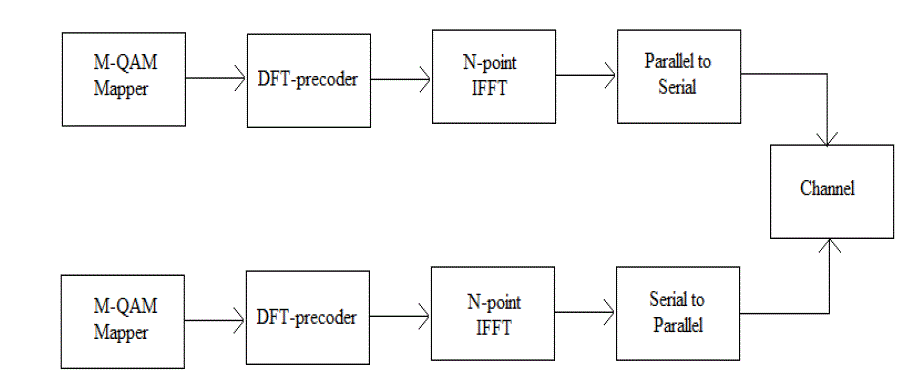 |
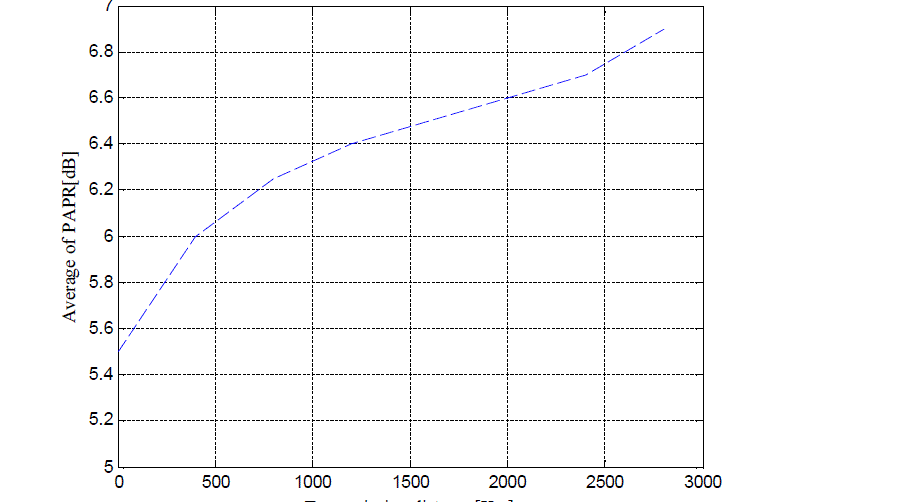 |
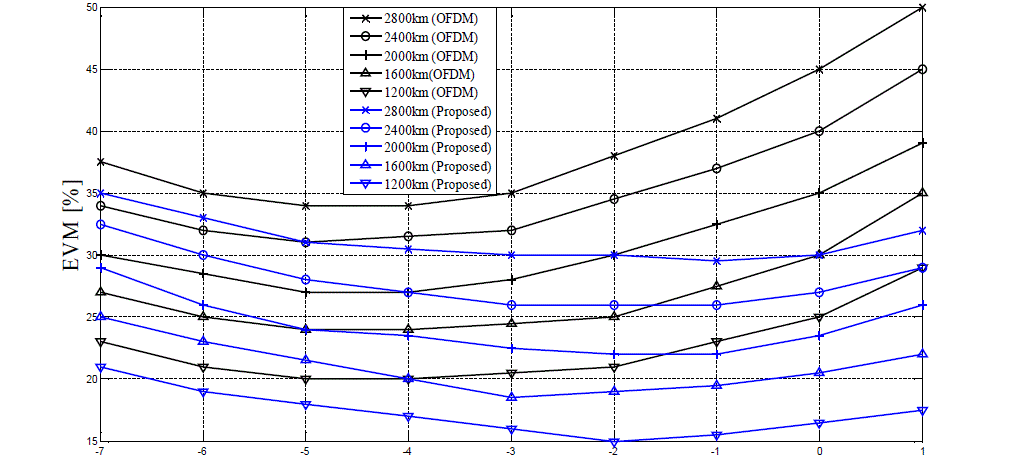 |
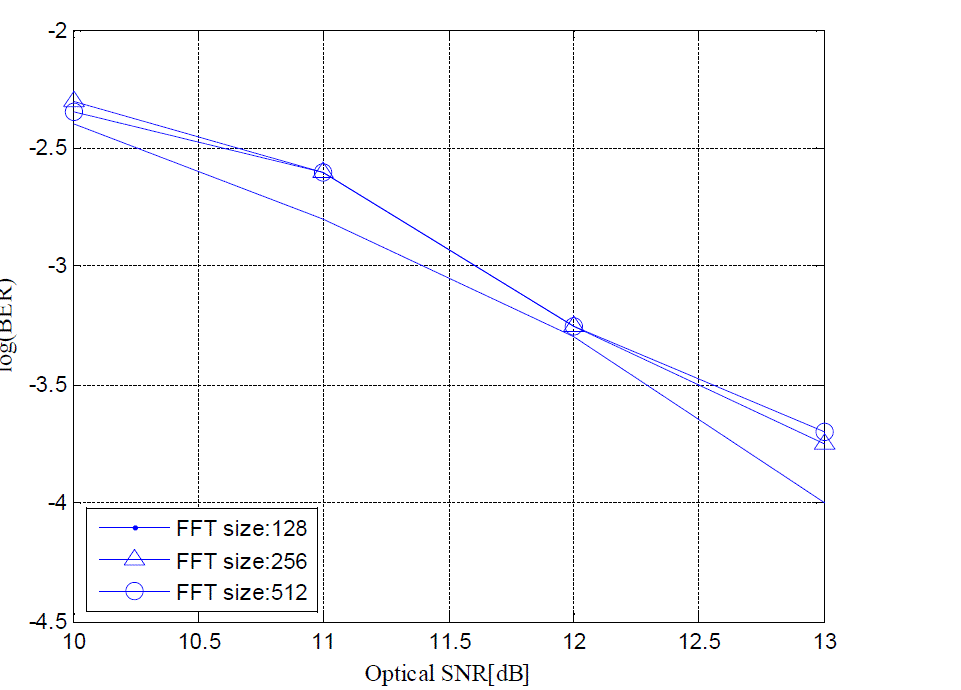 |
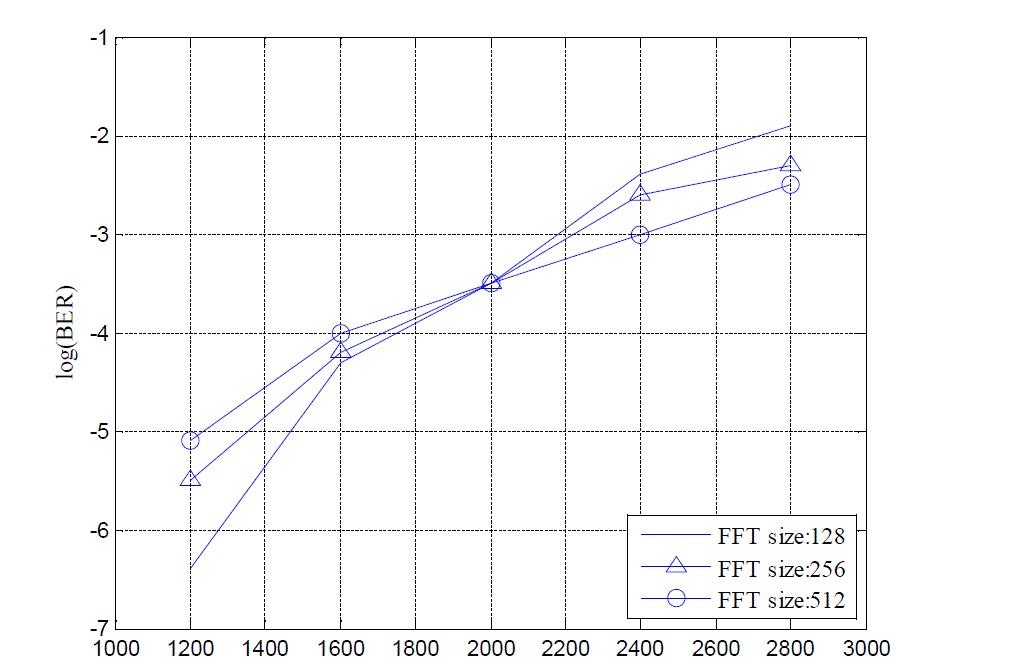 |
| Figure 1 |
Figure 2 |
Figure 3 |
Figure 4 |
Figure 5 |
|
References
|
- P.H.Moose A Technique for Orthogonal Frequency Division Multiplexing frequency offset correction, IEEE Trans. on Commun., Vol 42.No.10, pp 2908-2914, Oct 1994.
- S.H.Muller, J.B.Huber, A Comparison of Peak Power Reduction Sequences for OFDM , Global Telecommunications Conference, 1997.GLOBECOM '97., IEEE ,Volume: 1 , 3-8 Nov. 1997.
- R.van Nee and A. de Wild, “Reducing the Peak-To-Average Power\ Ratio of OFDM”, Vehicular Technology Conference, 1998. VTC98. 48thIEEE, Volume.3, 18-21, May 1998.
- A.D.S.Jayalath, C.Tellambura, The use of Interleaving to reduce the Peak to Average Power Ratio of an OFDM signal , GlobalTelecommunications Conference, 2000. GLOBECOM '00. IEEE ,Volume: 3 , 27 Nov.-1 Dec. 2000.
- S.B.Slimane, Peak to Average Power ratio reduction by Pulse Shaping. Global Telecommunications Conference, 2000. GLOBECOM '00.
- C. Zhao and R. Baxley, “Error vector magnitude analysis for OFDM systems,” in Proc. Asilomar Conf. Signals, Syst., Comput.(ACSSC),pp. 1830–1834, Oct.–Nov. 2006.
- Yajun Kou, Wu-Sheng Lu and Andreas Antoniou, “A new peak-toaverage power-ratio reduction algorithm for OFDM systems viaconstellation extension”, IEEE Trans. Wireless Communications, vol. 6, no. 5, pp. 1823–1832, May 2007.
- X. Wu, J. Wang, and Z. Mao, “A novel PTS architecture for PAPR reduction of OFDM signals,” in Proc. IEEE Int. Conf. Commun. Syst.(ICCS), pp. 1055–1060, China, 2008.
- VarunJeoti and Imran Baig, “Zero PAPR Zadoff-Chu Precoder Based Technique for SC-FDMA”, invited paper, Proceedings of 2009 IEEEInternational Conference on Antennas, Propagation and Systems (I_AS 2009), Johor, Malaysia, 3-5 Dec. 2009.
- Z. Huang, J. Li, S. Zhang, F. Zhang, and Z. Chen, “Investigations of SPM suppression by PAPR reduction in coherent optical OFDMsystems,” in Proc. Asia Commun. Photon. Conf. Exhibition (ACP), Paper Th05, 2009.
- J. Zhao and A. D. Ellis, “Discrete-Fourier transform based implementation for optical fast OFDM,” in Proc. Eur. Conf. Opt. Commun.(ECOC), Paper Tu.4.A.3, Torino, 2010.
- K. Yang, N. Prasad, and X.Wang, “Amessage-passing approach to distributed resource allocation in uplink DFT-spread-OFDMA systems,”IEEE Trans. Commun., vol. 59, no. 4, pp. 1099–1113, Apr. 2011.
- Y. Yoshida, A. Maruta, and K. Kitayama, “On the peak-to-average power ratio distribution along fiber in the optical OFDM transmissions,” inProc. Eur. Conf. Optical Commun. (ECOC), Paper We.10.P1.69, 2011.
- Mohamed A. Aboul-Dahab, Esam A. A. A. Hagras, and Ahmad A. Elhaseeb, “PAPR Reduction Based on DFT Precoding for OFDM Signals,”International Journal of Future Computer and Communication, Vol. 2, No. 4, August 2013.
- A. Venkata Sivaram & R. Srinivasa Rao, “PAPR Reduction of DHT and WHT-Precoded OFDM System for M-QAM”, ITSI Transactions onElectrical and Electronics Engineering (ITSI-TEEE) ISSN, ISSN (PRINT) : 2320 – 8945, Vol. 1, Issue 3, 2013
|